Business Decision Making Report: Payback and NPV Analysis
VerifiedAdded on 2023/06/06
|8
|1323
|460
Report
AI Summary
This report analyzes business decision-making processes, focusing on payback period and net present value (NPV) to evaluate two projects, A and B. It calculates the payback period for both projects and determines their NPV, comparing their financial viability. The report also examines the financial factors, such as investment objectives, risk, liquidity, and tax benefits, and non-financial factors, including customer satisfaction and environmental issues, that influence investment decisions. The analysis is based on the context of a manufacturing company, S&P PLC, and aims to provide insights into effective capital investment strategies. The conclusion summarizes the findings and highlights the importance of considering both financial and non-financial aspects in making informed investment decisions. References include books and journals related to business decision making and financial analysis.

Business Decision
Making
Making
Paraphrase This Document
Need a fresh take? Get an instant paraphrase of this document with our AI Paraphraser
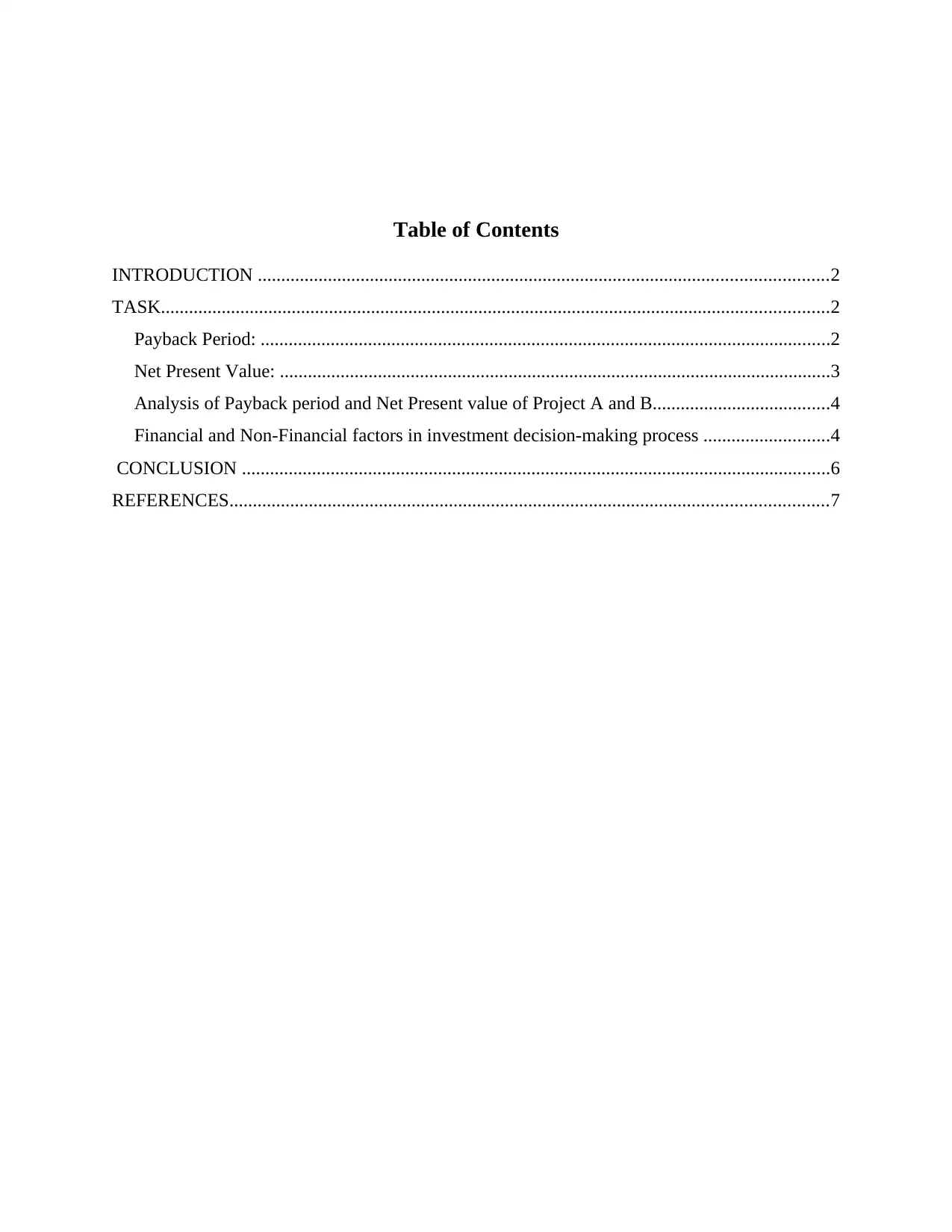
Table of Contents
INTRODUCTION ..........................................................................................................................2
TASK...............................................................................................................................................2
Payback Period: ..........................................................................................................................2
Net Present Value: ......................................................................................................................3
Analysis of Payback period and Net Present value of Project A and B......................................4
Financial and Non-Financial factors in investment decision-making process ...........................4
CONCLUSION ..............................................................................................................................6
REFERENCES................................................................................................................................7
INTRODUCTION ..........................................................................................................................2
TASK...............................................................................................................................................2
Payback Period: ..........................................................................................................................2
Net Present Value: ......................................................................................................................3
Analysis of Payback period and Net Present value of Project A and B......................................4
Financial and Non-Financial factors in investment decision-making process ...........................4
CONCLUSION ..............................................................................................................................6
REFERENCES................................................................................................................................7
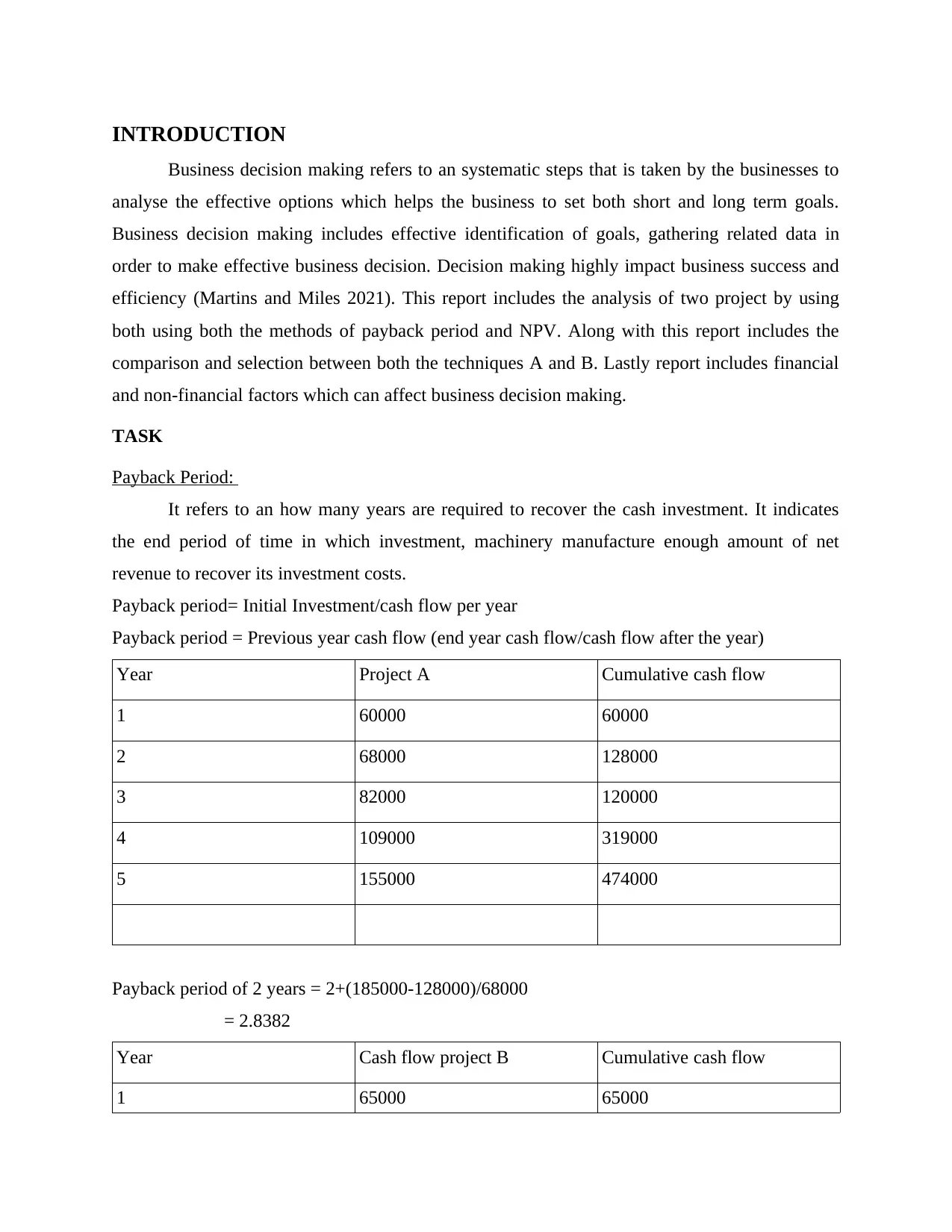
INTRODUCTION
Business decision making refers to an systematic steps that is taken by the businesses to
analyse the effective options which helps the business to set both short and long term goals.
Business decision making includes effective identification of goals, gathering related data in
order to make effective business decision. Decision making highly impact business success and
efficiency (Martins and Miles 2021). This report includes the analysis of two project by using
both using both the methods of payback period and NPV. Along with this report includes the
comparison and selection between both the techniques A and B. Lastly report includes financial
and non-financial factors which can affect business decision making.
TASK
Payback Period:
It refers to an how many years are required to recover the cash investment. It indicates
the end period of time in which investment, machinery manufacture enough amount of net
revenue to recover its investment costs.
Payback period= Initial Investment/cash flow per year
Payback period = Previous year cash flow (end year cash flow/cash flow after the year)
Year Project A Cumulative cash flow
1 60000 60000
2 68000 128000
3 82000 120000
4 109000 319000
5 155000 474000
Payback period of 2 years = 2+(185000-128000)/68000
= 2.8382
Year Cash flow project B Cumulative cash flow
1 65000 65000
Business decision making refers to an systematic steps that is taken by the businesses to
analyse the effective options which helps the business to set both short and long term goals.
Business decision making includes effective identification of goals, gathering related data in
order to make effective business decision. Decision making highly impact business success and
efficiency (Martins and Miles 2021). This report includes the analysis of two project by using
both using both the methods of payback period and NPV. Along with this report includes the
comparison and selection between both the techniques A and B. Lastly report includes financial
and non-financial factors which can affect business decision making.
TASK
Payback Period:
It refers to an how many years are required to recover the cash investment. It indicates
the end period of time in which investment, machinery manufacture enough amount of net
revenue to recover its investment costs.
Payback period= Initial Investment/cash flow per year
Payback period = Previous year cash flow (end year cash flow/cash flow after the year)
Year Project A Cumulative cash flow
1 60000 60000
2 68000 128000
3 82000 120000
4 109000 319000
5 155000 474000
Payback period of 2 years = 2+(185000-128000)/68000
= 2.8382
Year Cash flow project B Cumulative cash flow
1 65000 65000
⊘ This is a preview!⊘
Do you want full access?
Subscribe today to unlock all pages.

Trusted by 1+ million students worldwide
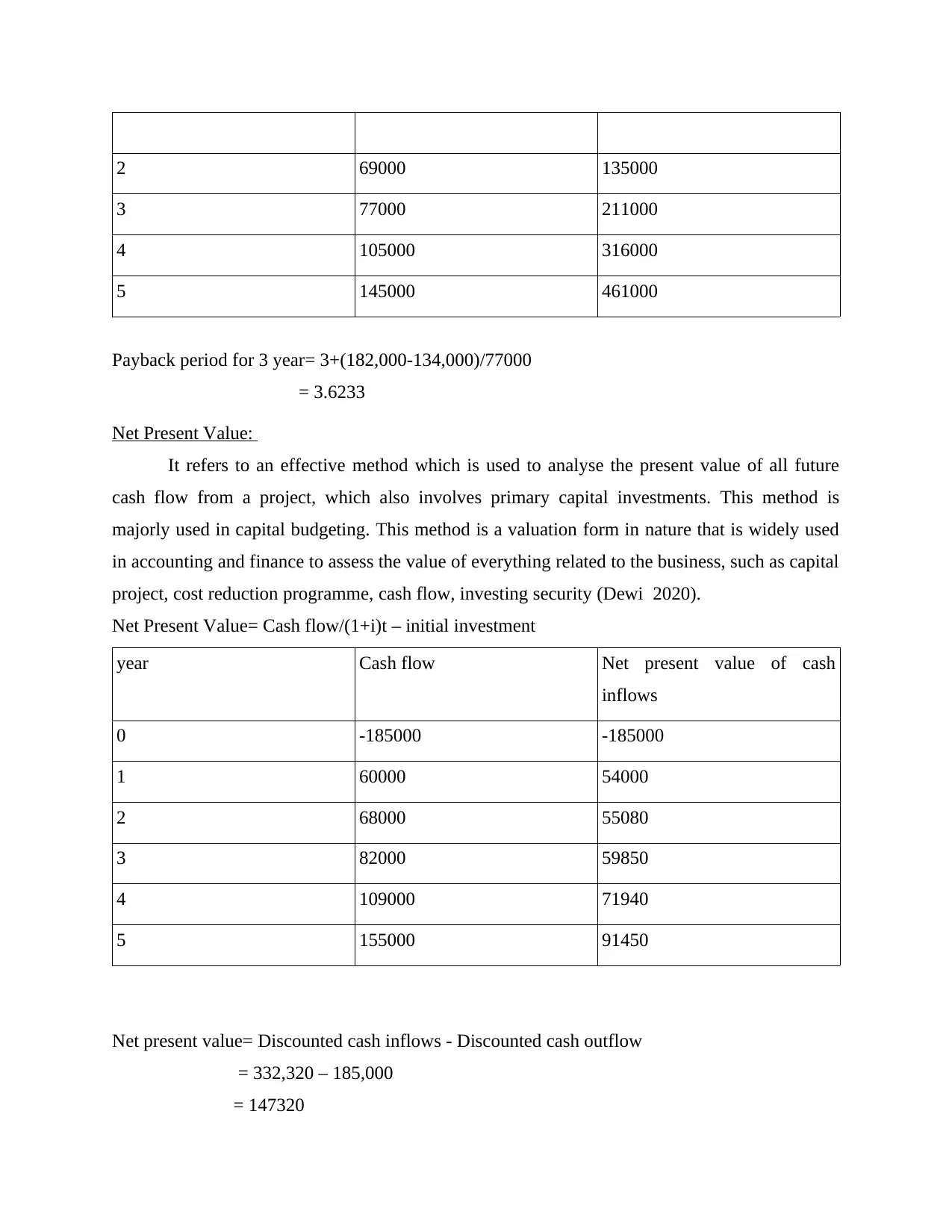
2 69000 135000
3 77000 211000
4 105000 316000
5 145000 461000
Payback period for 3 year= 3+(182,000-134,000)/77000
= 3.6233
Net Present Value:
It refers to an effective method which is used to analyse the present value of all future
cash flow from a project, which also involves primary capital investments. This method is
majorly used in capital budgeting. This method is a valuation form in nature that is widely used
in accounting and finance to assess the value of everything related to the business, such as capital
project, cost reduction programme, cash flow, investing security (Dewi 2020).
Net Present Value= Cash flow/(1+i)t – initial investment
year Cash flow Net present value of cash
inflows
0 -185000 -185000
1 60000 54000
2 68000 55080
3 82000 59850
4 109000 71940
5 155000 91450
Net present value= Discounted cash inflows - Discounted cash outflow
= 332,320 – 185,000
= 147320
3 77000 211000
4 105000 316000
5 145000 461000
Payback period for 3 year= 3+(182,000-134,000)/77000
= 3.6233
Net Present Value:
It refers to an effective method which is used to analyse the present value of all future
cash flow from a project, which also involves primary capital investments. This method is
majorly used in capital budgeting. This method is a valuation form in nature that is widely used
in accounting and finance to assess the value of everything related to the business, such as capital
project, cost reduction programme, cash flow, investing security (Dewi 2020).
Net Present Value= Cash flow/(1+i)t – initial investment
year Cash flow Net present value of cash
inflows
0 -185000 -185000
1 60000 54000
2 68000 55080
3 82000 59850
4 109000 71940
5 155000 91450
Net present value= Discounted cash inflows - Discounted cash outflow
= 332,320 – 185,000
= 147320
Paraphrase This Document
Need a fresh take? Get an instant paraphrase of this document with our AI Paraphraser
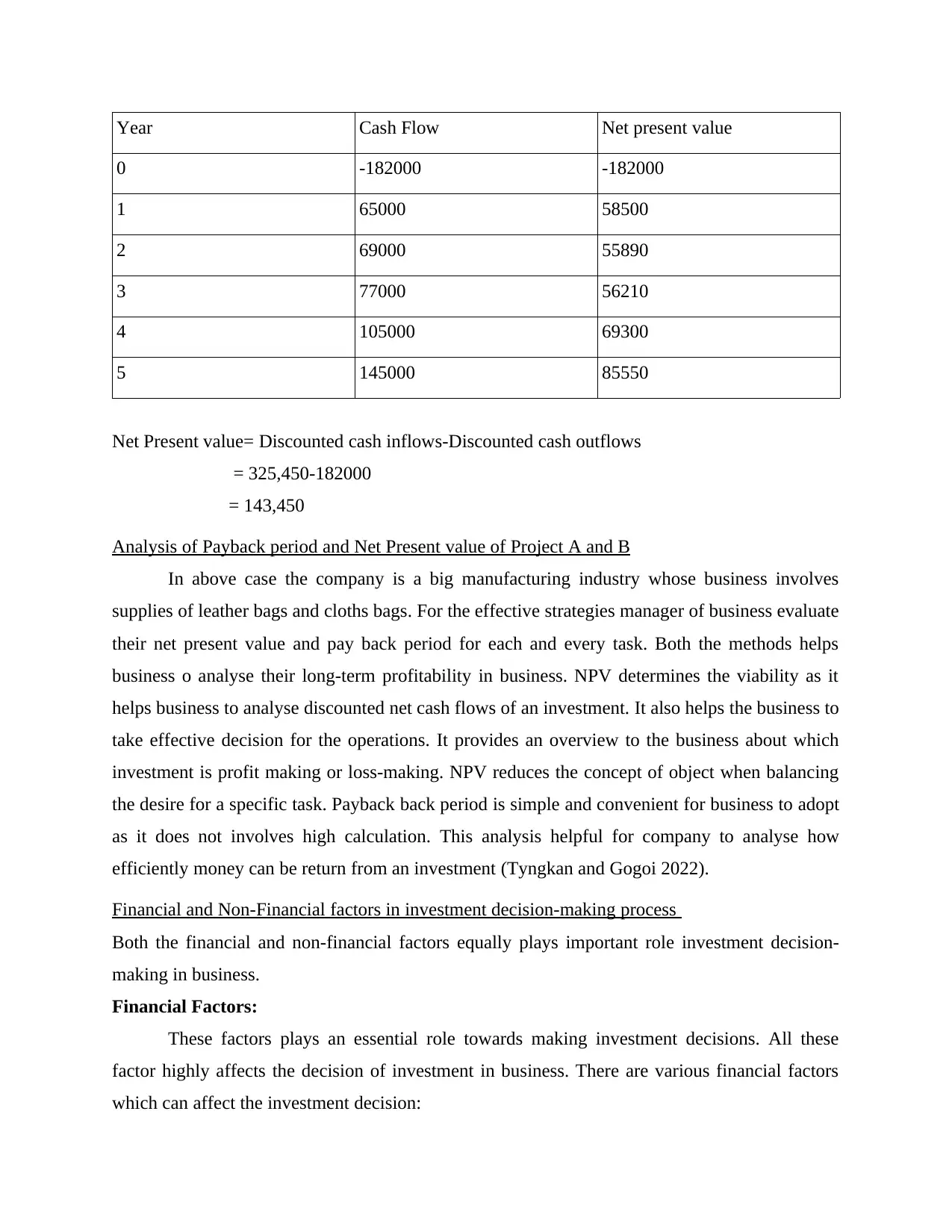
Year Cash Flow Net present value
0 -182000 -182000
1 65000 58500
2 69000 55890
3 77000 56210
4 105000 69300
5 145000 85550
Net Present value= Discounted cash inflows-Discounted cash outflows
= 325,450-182000
= 143,450
Analysis of Payback period and Net Present value of Project A and B
In above case the company is a big manufacturing industry whose business involves
supplies of leather bags and cloths bags. For the effective strategies manager of business evaluate
their net present value and pay back period for each and every task. Both the methods helps
business o analyse their long-term profitability in business. NPV determines the viability as it
helps business to analyse discounted net cash flows of an investment. It also helps the business to
take effective decision for the operations. It provides an overview to the business about which
investment is profit making or loss-making. NPV reduces the concept of object when balancing
the desire for a specific task. Payback back period is simple and convenient for business to adopt
as it does not involves high calculation. This analysis helpful for company to analyse how
efficiently money can be return from an investment (Tyngkan and Gogoi 2022).
Financial and Non-Financial factors in investment decision-making process
Both the financial and non-financial factors equally plays important role investment decision-
making in business.
Financial Factors:
These factors plays an essential role towards making investment decisions. All these
factor highly affects the decision of investment in business. There are various financial factors
which can affect the investment decision:
0 -182000 -182000
1 65000 58500
2 69000 55890
3 77000 56210
4 105000 69300
5 145000 85550
Net Present value= Discounted cash inflows-Discounted cash outflows
= 325,450-182000
= 143,450
Analysis of Payback period and Net Present value of Project A and B
In above case the company is a big manufacturing industry whose business involves
supplies of leather bags and cloths bags. For the effective strategies manager of business evaluate
their net present value and pay back period for each and every task. Both the methods helps
business o analyse their long-term profitability in business. NPV determines the viability as it
helps business to analyse discounted net cash flows of an investment. It also helps the business to
take effective decision for the operations. It provides an overview to the business about which
investment is profit making or loss-making. NPV reduces the concept of object when balancing
the desire for a specific task. Payback back period is simple and convenient for business to adopt
as it does not involves high calculation. This analysis helpful for company to analyse how
efficiently money can be return from an investment (Tyngkan and Gogoi 2022).
Financial and Non-Financial factors in investment decision-making process
Both the financial and non-financial factors equally plays important role investment decision-
making in business.
Financial Factors:
These factors plays an essential role towards making investment decisions. All these
factor highly affects the decision of investment in business. There are various financial factors
which can affect the investment decision:
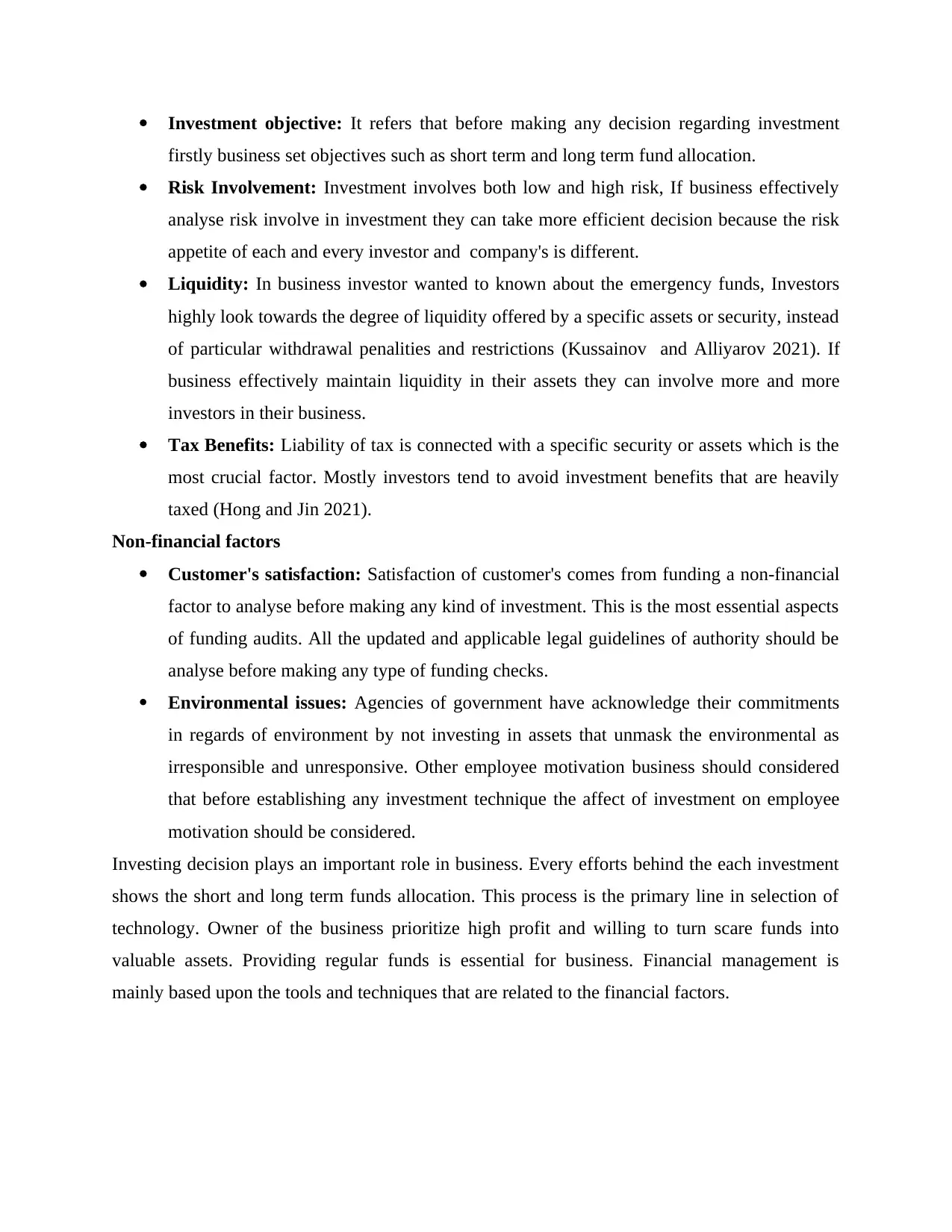
Investment objective: It refers that before making any decision regarding investment
firstly business set objectives such as short term and long term fund allocation.
Risk Involvement: Investment involves both low and high risk, If business effectively
analyse risk involve in investment they can take more efficient decision because the risk
appetite of each and every investor and company's is different.
Liquidity: In business investor wanted to known about the emergency funds, Investors
highly look towards the degree of liquidity offered by a specific assets or security, instead
of particular withdrawal penalities and restrictions (Kussainov and Alliyarov 2021). If
business effectively maintain liquidity in their assets they can involve more and more
investors in their business.
Tax Benefits: Liability of tax is connected with a specific security or assets which is the
most crucial factor. Mostly investors tend to avoid investment benefits that are heavily
taxed (Hong and Jin 2021).
Non-financial factors
Customer's satisfaction: Satisfaction of customer's comes from funding a non-financial
factor to analyse before making any kind of investment. This is the most essential aspects
of funding audits. All the updated and applicable legal guidelines of authority should be
analyse before making any type of funding checks.
Environmental issues: Agencies of government have acknowledge their commitments
in regards of environment by not investing in assets that unmask the environmental as
irresponsible and unresponsive. Other employee motivation business should considered
that before establishing any investment technique the affect of investment on employee
motivation should be considered.
Investing decision plays an important role in business. Every efforts behind the each investment
shows the short and long term funds allocation. This process is the primary line in selection of
technology. Owner of the business prioritize high profit and willing to turn scare funds into
valuable assets. Providing regular funds is essential for business. Financial management is
mainly based upon the tools and techniques that are related to the financial factors.
firstly business set objectives such as short term and long term fund allocation.
Risk Involvement: Investment involves both low and high risk, If business effectively
analyse risk involve in investment they can take more efficient decision because the risk
appetite of each and every investor and company's is different.
Liquidity: In business investor wanted to known about the emergency funds, Investors
highly look towards the degree of liquidity offered by a specific assets or security, instead
of particular withdrawal penalities and restrictions (Kussainov and Alliyarov 2021). If
business effectively maintain liquidity in their assets they can involve more and more
investors in their business.
Tax Benefits: Liability of tax is connected with a specific security or assets which is the
most crucial factor. Mostly investors tend to avoid investment benefits that are heavily
taxed (Hong and Jin 2021).
Non-financial factors
Customer's satisfaction: Satisfaction of customer's comes from funding a non-financial
factor to analyse before making any kind of investment. This is the most essential aspects
of funding audits. All the updated and applicable legal guidelines of authority should be
analyse before making any type of funding checks.
Environmental issues: Agencies of government have acknowledge their commitments
in regards of environment by not investing in assets that unmask the environmental as
irresponsible and unresponsive. Other employee motivation business should considered
that before establishing any investment technique the affect of investment on employee
motivation should be considered.
Investing decision plays an important role in business. Every efforts behind the each investment
shows the short and long term funds allocation. This process is the primary line in selection of
technology. Owner of the business prioritize high profit and willing to turn scare funds into
valuable assets. Providing regular funds is essential for business. Financial management is
mainly based upon the tools and techniques that are related to the financial factors.
⊘ This is a preview!⊘
Do you want full access?
Subscribe today to unlock all pages.

Trusted by 1+ million students worldwide
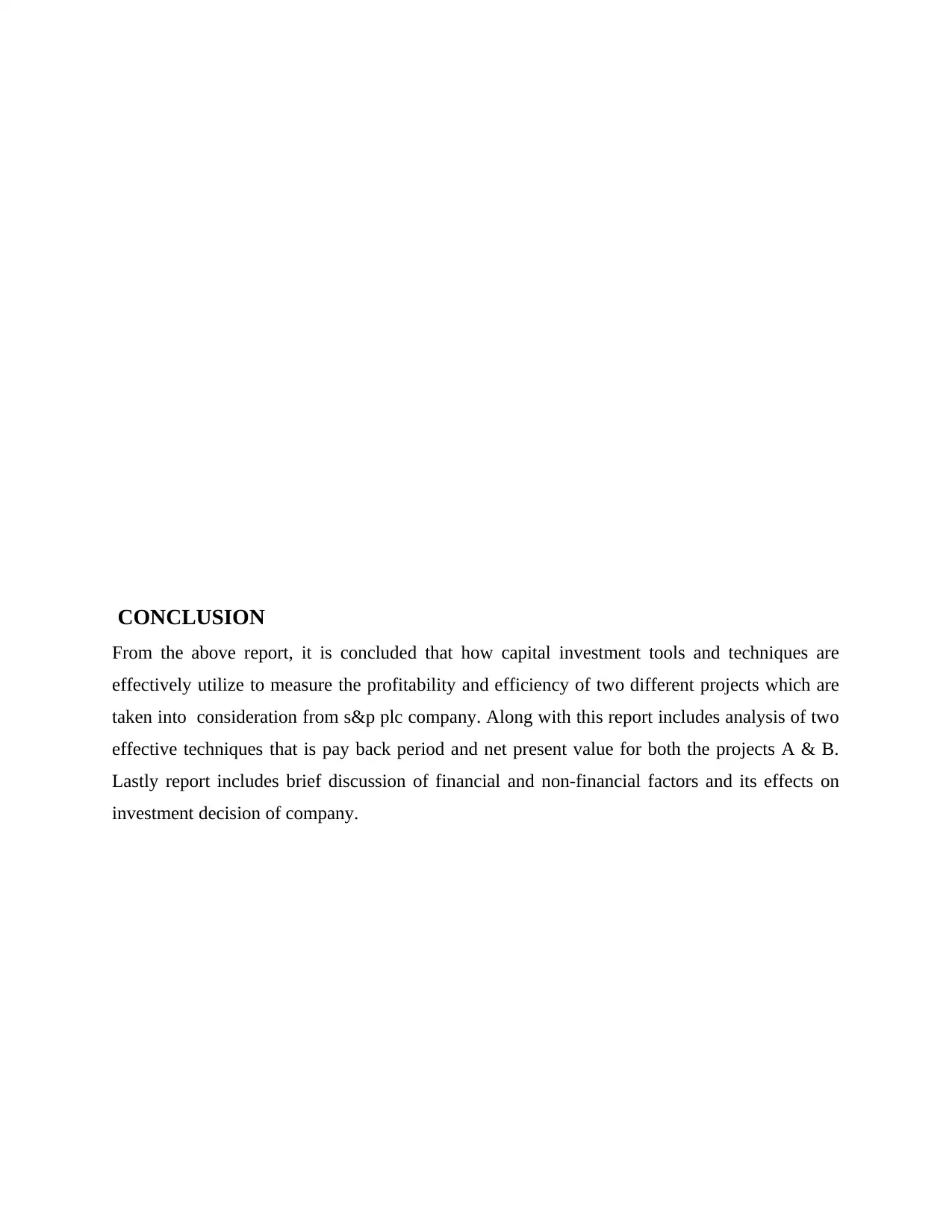
CONCLUSION
From the above report, it is concluded that how capital investment tools and techniques are
effectively utilize to measure the profitability and efficiency of two different projects which are
taken into consideration from s&p plc company. Along with this report includes analysis of two
effective techniques that is pay back period and net present value for both the projects A & B.
Lastly report includes brief discussion of financial and non-financial factors and its effects on
investment decision of company.
From the above report, it is concluded that how capital investment tools and techniques are
effectively utilize to measure the profitability and efficiency of two different projects which are
taken into consideration from s&p plc company. Along with this report includes analysis of two
effective techniques that is pay back period and net present value for both the projects A & B.
Lastly report includes brief discussion of financial and non-financial factors and its effects on
investment decision of company.
Paraphrase This Document
Need a fresh take? Get an instant paraphrase of this document with our AI Paraphraser
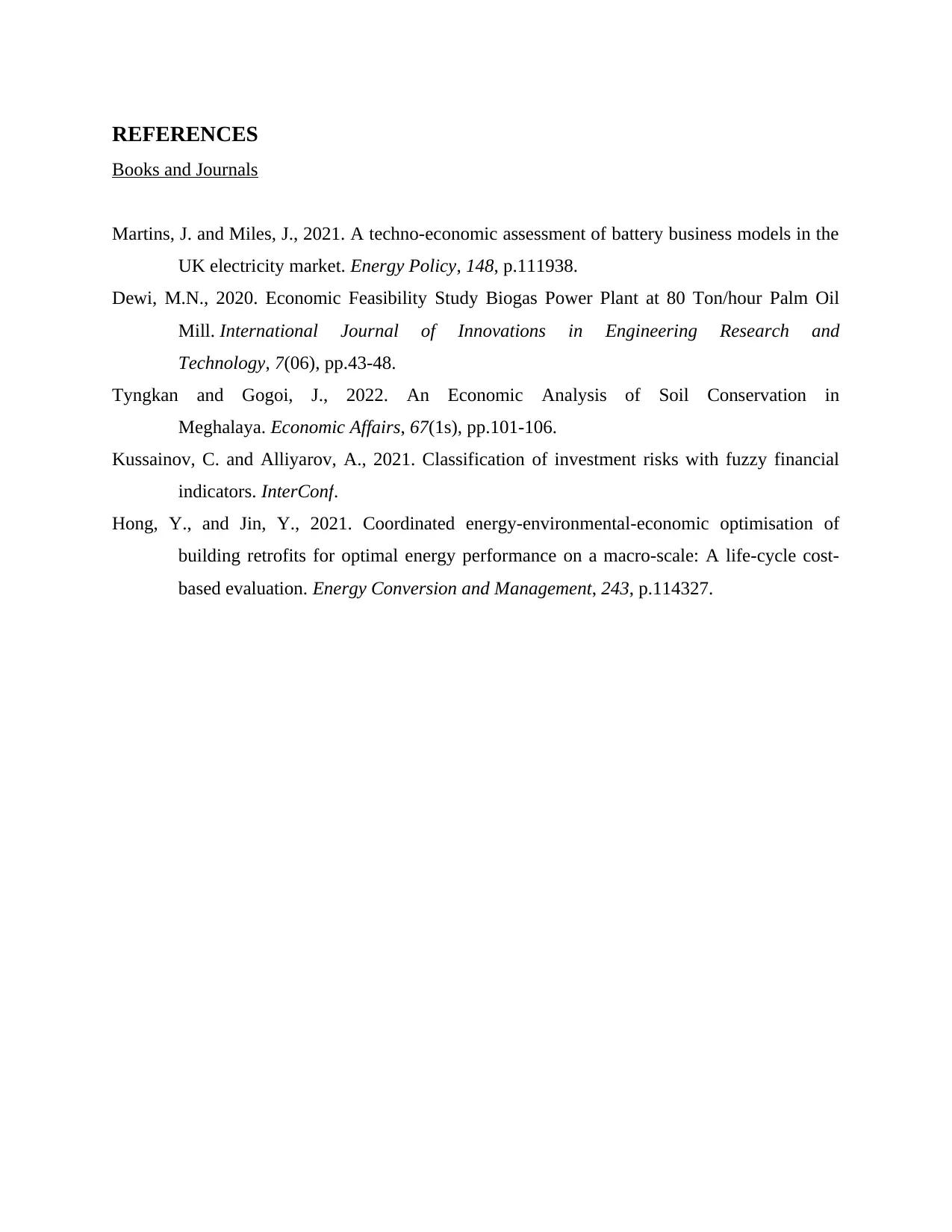
REFERENCES
Books and Journals
Martins, J. and Miles, J., 2021. A techno-economic assessment of battery business models in the
UK electricity market. Energy Policy, 148, p.111938.
Dewi, M.N., 2020. Economic Feasibility Study Biogas Power Plant at 80 Ton/hour Palm Oil
Mill. International Journal of Innovations in Engineering Research and
Technology, 7(06), pp.43-48.
Tyngkan and Gogoi, J., 2022. An Economic Analysis of Soil Conservation in
Meghalaya. Economic Affairs, 67(1s), pp.101-106.
Kussainov, C. and Alliyarov, A., 2021. Classification of investment risks with fuzzy financial
indicators. InterConf.
Hong, Y., and Jin, Y., 2021. Coordinated energy-environmental-economic optimisation of
building retrofits for optimal energy performance on a macro-scale: A life-cycle cost-
based evaluation. Energy Conversion and Management, 243, p.114327.
Books and Journals
Martins, J. and Miles, J., 2021. A techno-economic assessment of battery business models in the
UK electricity market. Energy Policy, 148, p.111938.
Dewi, M.N., 2020. Economic Feasibility Study Biogas Power Plant at 80 Ton/hour Palm Oil
Mill. International Journal of Innovations in Engineering Research and
Technology, 7(06), pp.43-48.
Tyngkan and Gogoi, J., 2022. An Economic Analysis of Soil Conservation in
Meghalaya. Economic Affairs, 67(1s), pp.101-106.
Kussainov, C. and Alliyarov, A., 2021. Classification of investment risks with fuzzy financial
indicators. InterConf.
Hong, Y., and Jin, Y., 2021. Coordinated energy-environmental-economic optimisation of
building retrofits for optimal energy performance on a macro-scale: A life-cycle cost-
based evaluation. Energy Conversion and Management, 243, p.114327.
1 out of 8
Related Documents
Your All-in-One AI-Powered Toolkit for Academic Success.
+13062052269
info@desklib.com
Available 24*7 on WhatsApp / Email
![[object Object]](/_next/static/media/star-bottom.7253800d.svg)
Unlock your academic potential
Copyright © 2020–2025 A2Z Services. All Rights Reserved. Developed and managed by ZUCOL.



